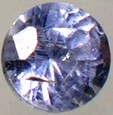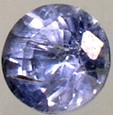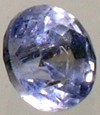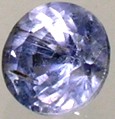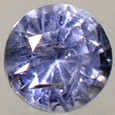
Antique Handcrafted Genuine Natural Russian Cornflower Blue Sapphire Faceted Round. CLASSIFICATION: Faceted Blue Sapphire Round. ORIGIN: The Ural Mountains, Russia. 19th Century. SIZE: Diameter: 3 1/4mm. Depth: 1 3/4mm. All measurements approximate WEIGHT: Approximately 0.18 carats. NOTES: Upon request we can set your gemstone as a ring, earring, or pendant (click here for more information).
DETAIL: A gorgeous, vibrantly colored natural bright blue sapphire precious gemstone from the Ural Mountains of Russia. The gemstone was hand crafted and faceted by a 19th century Russian artisan, part of an heritage renown for the production of the elaborate gemstones and jewelry of the Czars of Medieval, Renaissance, and Victorian Russia. The faceted cut is a coarse precursor to what eventually became known in the industry as a "brilliant cut" round, the contemporary finish generally given to round diamonds. The results is an exquisite and incredibly beautifully colored precious gemstone with lots of depth, fire and sparkle. Cut and faceted just like a diamond, it looks just like a pastel blue diamond. This is a real sparkler, and this color sapphire is definitely much in demand.
The color is a very beautiful blue, the color very reminiscent of the shade often called "cornflower" blue after the fabulous Kashmiri sapphires (from Kashmir, India) which played out in the nineteenth century. The color is quite exquisite, and well-saturated (not washed out). There might be just barely detectable a little color zoning, which means that if you look very carefully and closely under magnification you might see slightly different shades of color within the gemstones. But this is quite common with sapphires, and in no way detracts from their beauty. Aside from being commonplace, the color zoning is not detectable at all except upon very close scrutiny (such as photo enlargements like these).
The gemstone is to the eye, virtually flawless. Even in these photo enlargements here (500%) it is impossible to discern any blemishes. This is really an exceptional precious gemstone, completely transparent, with every bit as much sparkle and brilliance as a diamond, it is truly a very flashy gemstone, the color and quality both fabulous! High quality blue sapphires such as this are increasingly difficult to acquire at anything approaching a reasonable price. Unfortunately most seemingly flawless, transparent "sapphires" sold even by the largest and most reputable retailers in the United States are synthetic (read the fine print; and the same is true of emeralds and rubies). However the Southern Ural Mountains of Russia have been producing good quality, natural sapphires for centuries.
Under magnification the gemstone shows the unmistakable characteristics of having been hand crafted. The coarseness of the 19th century finish is considered appealing to most gemstone collectors, and is not considered a detriment, or detract from the value of a gemstone. These characteristics are not only expected of hand-finished gemstones, most serious collectors consider such gemstones more desirable, possessed of greater character and uniqueness when compared to today's cookie-cutter mass-produced machine-faceted gemstones. Unlike today's computer controlled machine produced gemstones, the cut and finish of a gemstone such as this is the legacy of an artisan who lived two centuries ago.
This gemstone possesses superb luster and sparkle, and to the eye is completely transparent, but one cannot say with absolute certainty that it is unconditionally flawless. True, the blemishes it possesses are not visible to the naked eye, and the gemstone can be characterized at a minimum, to use trade jargon, as "eye clean", it even approaches "loupe clean". To the eye it is indeed flawless; however magnified 600%, as it is here, you might be able to just barely pick out one or two slight imperfections within the gemstone, barely perceptible even at such high magnification. Of course the same may said about almost any natural gemstone. An absolutely flawless gemstone simply is not the rule in nature. Most absolutely flawless gemstones will upon close examination be revealed to be synthetic. You might also notice under magnification occasional irregularities in the cut and finish.
Naturally these characteristics are not only expected of hand-finished gemstones, you must also consider that two centuries ago the mining techniques prevalent did not allow the ultra deep mining operations which are so common today. Keep in mind that two centuries ago mankind was more or less limited to surface deposits or near surface deposits of gemstones. Higher quality gemstones which today are routinely mined from beneath hundreds of meters, even kilometers beneath the earth's surface, were simply inaccessible then. For these reasons antique gemstones must be appreciated as antiques first, gemstones second. The relatively superlative quality of contemporary gemstones routinely mined from deep beneath the earth's surface today were simply not accessible two centuries ago, or at least, only rarely so. However for most, the unique nature and character of antique gemstones such as this more than makes up for included imperfections which by and large, are (if at all) only visible under high magnification. HISTORY: Mentions of sapphire in ancient references reach well back past 800 B.C. Certainly the ancient Greeks, Persians, and Romans all knew of blue sapphires and employed the precious gemstones in their jewelry. In the world of the ancient Mediterranean, priests and sorcerers honored the sapphire above all other gems. As the centuries passed, European royalty came to highly favor sapphires believing the stone would provide protection from harm. In the medieval world blue sapphires were believed to represent heaven, and thus the precious gemstones were widely used in ecclesiastical jewelry. Sapphires are a member of the corundum family, as are rubies, and as such sapphires are considered one of the most valuable of precious stones. They are also extremely hard, second only to diamonds, and so are very popular as gemstones for rings and pendants. Sapphires are mined in Thailand, Ceylon, Burma, Australia, Madagascar, Russia, South Africa, China, Afghanistan, and in Montana and North Carolina..
SHIPPING OPTIONS: All purchases are backed by an unlimited guarantee of satisfaction and authenticity. If for any reason you are not entirely satisfied with your purchase, you may return it for a complete and immediate refund of your entire purchase price. Most of these antique gemstones were originally part of two collections, one originating in India principally composed of gemstones originally mined in India, Burma, Ceylon, and Siam, and then hand faceted in India. The addition of a second accumulation of antique gemstones originally mined in the Urals in the mid to late 19th century (including alexandrite) completed the collection. These gemstones as well were hand finished. The Urals have been one of the world's major sources of precious and semi-precious gemstones for many centuries. As well, additional specimens are occasionally acquired from other institutions and dealers in Eastern Europe and Asia. These antique gemstones are now in the United States and are available for immediate delivery. We ship inventory from the USA order fulfillment center near Seattle, Washington. Your purchase will ordinarily be shipping within 48 hours of payment. A certificate of authenticity is available upon request. We prefer your personal check or money order over any other form of payment - and we will ship immediately upon receipt of your check (no "holds"). We will accept PayPal payments. Please see our "ADDITIONAL TERMS OF SALE".
|
|---|
